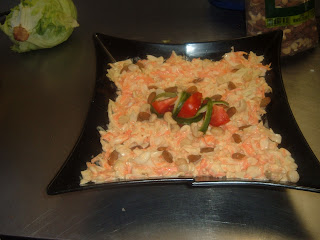Skills Proficiency in Basic Food and Beverage Services:
| Working on Plus Point |
This course was also very interesting for me I’ve enjoyed every moment of it and learned a lot in this course. Personal presentation , good communication skills as well as the right use of body language and customer care skills are very important because at food and beverage you work directly with guests.
Team work is also one of the most important aspects when working at food and beverage because teamwork leads to success in the company and to make sure that the companies standards are achieved every moment.
| Making Cuppacino |
Respect for yourself as well as for the people you work with is very important. I’ve learned a lot about respect also in this course as well as the different kinds of cultures and the importance of respecting the different of cultures.
I’ve learned a lot here at food and beverage especially when I was working as a waiter at Sondela for practical experience . I’ve learned the importance of customer care and how to deal with the different kinds of customers that comes to visit Sondela.
I received a lot of compliments direct from guests when I was their waiter and that made me even more proud to be part of the Sondela family.
The 3 different modules we did in Food and Beverage and some of the things I’ve learned:
· How to carry out safe working practices to prevent hazards and how to ensure the safety of working personnel and members of the public.
· The importance of reporting any personal condition that could affect food and safety and how to take the appropriate actions.
· Inspect for faults of equipment and how to set up and use equipment safely.
· How to maintain a clean work area and equipment.
· The importance of ensuring that all foods are protected from contamination.
· How to apply good housekeeping practices.
· How to carry out the basic first aid procedures.
· How to observe all of the establishment’s security procedures.
· The importance and methods of hazard prevention,
· Dangers associated with the use of equipment and materials in the workplace.
· Faults that can make the equipment unsafe to use.
· Toxic effect of substances used in the workplace.
· The procedure for safe storage of materials.
· Basic first aid procedures for:
- Fractures
- Shock
- Electrical shock
- Burns
- Fainting
As well as what the contents of a first aid box are and how the checks of the first aid boxes work like.
· What the main sources of contamination in the service of food and beverage are: microbiological, chemical and physical.
· What the responsibilities of food handlers are.
- What the simple cookery terms such as boiling, poaching, stewing, braising, steaming, baking, roasting, pot roasting, grilling, shallow frying and deep frying are in order to explain this terms to guests when they like to know what is means when ordering food.
- How to select appropriate equipment according to the menu of the meal.
- How to organize all routines and special requirements related to the menu.
- What equipment to select for beverage services that is appropriate.
- How to carry out all service preparation with appropriate speed and quality.
- Serve customer orders according to the appropriate style.
- Ensure that all clear down and storing procedures are appropriate carried out.
- The factors involved in meeting pre-service deadlines for example:
Ø Planning
Ø Providing sufficient equipment
Ø Provision of accompaniments
Ø Standard working methods
Ø Systemised order taking
Ø The importance of team work
- Methods and procedures for greeting and seating guests.
- Methods and procedures for serving guests.
- The procedures for presenting the bill and how the customer exit work like.
- What the basic cooking preparation times are.
- What different cultural needs and special diets there are.
- What items are served at the table.
- The different non-alcoholic beverages there are and the procedures to serve them.
§ How to communicate effectively and professionally with customers and colleagues.
§ How to great and seat guests promptly and according to the establishments procedures.
§ The right procedures for handling customer’s requirements promptly and politely.
§ How to carry our dealings with customers in a confidential and appropriate manner.
§ Security considerations in the different areas of the workplace.
§ The correct procedures for handling and reporting lost and found property.
§ Methods of maintaining communication skills.
§ The different factors which contribute to successful team work.
§ Skills required for dealing with different types of customers.




























